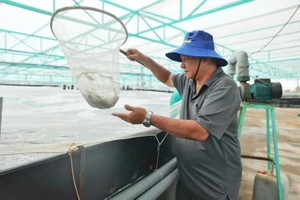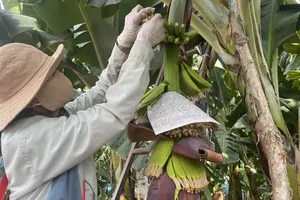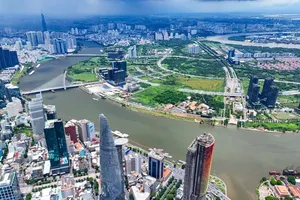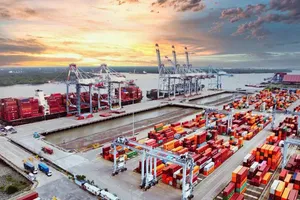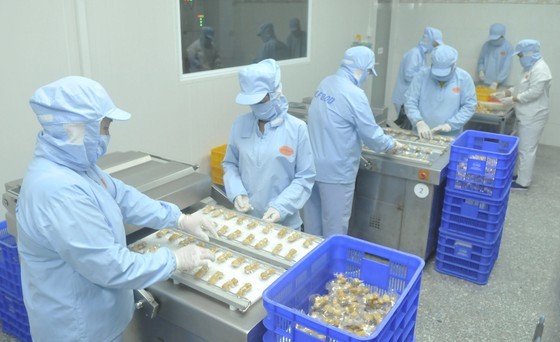
Although it continues to be the lowest growth rate in the same period in recent years, in the context that many countries around the world, especially the leading economies, have still suffered because of the Covid-19 pandemic (the forecast for global economic growth for this year dropped by 5.2 percent - the highest recession in the past eight decades), the economic growth of Vietnam is considered a great success.
The indicators of the economic health of Vietnam in 2020 are still fairly good. Specifically, the interest rate level decreased; the exchange rate and foreign exchange market were stable, and market liquidity was ensured; the foreign exchange reserves were at the highest level ever. This year, the average consumer price index (CPI) is expected to increase 3.5-3.9 percent while the target is below 4 percent. The mobilization of investment capital for social development is estimated at 33.6 percent of GDP while the target is 33-34 percent of GDP. Especially, the crucial highlight of the economy is the increase in exports with a trade surplus of US$17 billion after nine months in the context of a sharp decline in global trade. Besides, the export turnover of the domestic sector rose strongly.
At a press conference held at the end of September, Ms. Nguyen Thi Huong, General Director of the General Statistics Office of Vietnam, said that in the fourth quarter, the situation would likely be more positive. Up to 82.8 percent of enterprises in the FDI sector predicted that the production and business situation in the fourth quarter was better and stable compared to the third quarter. This rate in the state-owned and non-state sectors was 81.7 percent and 80.2 percent respectively. Of course, when enterprises consider that the situation will be better, the economy will grow.
Another support to stay optimistic is the potential of public investment disbursement. Mr. Duong Manh Hung, Director of the Department of National Account System under the GSO, said that normally, in the last quarter of the year, the disbursement rate of public investment capital would be accelerated more strongly compared to the first quarters of the year.
Meanwhile, the investment capital from the State budget in the last nine months is estimated to reach VND303 trillion, equaling to 59.7 percent of this year’s plan, and up by 33.3 percent over the same period, the highest level in the period from 2016 to 2020, which has made an important contribution to maintaining the momentum of economic growth in the context that the Covid-19 pandemic has been controlled well.
The latest report that the Ministry of Planning and Investment recently sent to the Government said that if nothing unusual happens during the last months of the year, the GDP growth rate can reach about 2.51 percent. Meanwhile, the World Bank (WB) said that if the situation in the world is favorable, Vietnam can achieve a growth rate of 2.8 percent this year.
However, the economic health of Vietnam has also eroded. The most obvious is that the State's wallet has gotten much thinner. Mr. Vu Hong Thanh, Chairman of the Economic Committee of the National Assembly of Vietnam, expressed his concern as the total state budget revenue from the beginning of the year to September 15 was estimated at VND902.5 trillion, merely accounting for 59.7 percent of the yearly budget estimate - the lowest level in the past ten years.
Although the economy saw a trade surplus of $17 billion, the export growth was merely at 4.2 percent, exceeding $202 billion. It shows that the high trade surplus is partly caused by the decrease in imports - a consequence of the failure of enterprises in purchasing input materials for production. Inflation is under control, but the nine-month CPI has reached 3.85 percent, near the ceiling of 4 percent. Hence, there is not much room for price management in the last months of the year. Meanwhile, according to the law of markets, prices tend to soar in the last months of the year.
The indicators of the economic health of Vietnam in 2020 are still fairly good. Specifically, the interest rate level decreased; the exchange rate and foreign exchange market were stable, and market liquidity was ensured; the foreign exchange reserves were at the highest level ever. This year, the average consumer price index (CPI) is expected to increase 3.5-3.9 percent while the target is below 4 percent. The mobilization of investment capital for social development is estimated at 33.6 percent of GDP while the target is 33-34 percent of GDP. Especially, the crucial highlight of the economy is the increase in exports with a trade surplus of US$17 billion after nine months in the context of a sharp decline in global trade. Besides, the export turnover of the domestic sector rose strongly.
At a press conference held at the end of September, Ms. Nguyen Thi Huong, General Director of the General Statistics Office of Vietnam, said that in the fourth quarter, the situation would likely be more positive. Up to 82.8 percent of enterprises in the FDI sector predicted that the production and business situation in the fourth quarter was better and stable compared to the third quarter. This rate in the state-owned and non-state sectors was 81.7 percent and 80.2 percent respectively. Of course, when enterprises consider that the situation will be better, the economy will grow.
Another support to stay optimistic is the potential of public investment disbursement. Mr. Duong Manh Hung, Director of the Department of National Account System under the GSO, said that normally, in the last quarter of the year, the disbursement rate of public investment capital would be accelerated more strongly compared to the first quarters of the year.
Meanwhile, the investment capital from the State budget in the last nine months is estimated to reach VND303 trillion, equaling to 59.7 percent of this year’s plan, and up by 33.3 percent over the same period, the highest level in the period from 2016 to 2020, which has made an important contribution to maintaining the momentum of economic growth in the context that the Covid-19 pandemic has been controlled well.
The latest report that the Ministry of Planning and Investment recently sent to the Government said that if nothing unusual happens during the last months of the year, the GDP growth rate can reach about 2.51 percent. Meanwhile, the World Bank (WB) said that if the situation in the world is favorable, Vietnam can achieve a growth rate of 2.8 percent this year.
However, the economic health of Vietnam has also eroded. The most obvious is that the State's wallet has gotten much thinner. Mr. Vu Hong Thanh, Chairman of the Economic Committee of the National Assembly of Vietnam, expressed his concern as the total state budget revenue from the beginning of the year to September 15 was estimated at VND902.5 trillion, merely accounting for 59.7 percent of the yearly budget estimate - the lowest level in the past ten years.
Although the economy saw a trade surplus of $17 billion, the export growth was merely at 4.2 percent, exceeding $202 billion. It shows that the high trade surplus is partly caused by the decrease in imports - a consequence of the failure of enterprises in purchasing input materials for production. Inflation is under control, but the nine-month CPI has reached 3.85 percent, near the ceiling of 4 percent. Hence, there is not much room for price management in the last months of the year. Meanwhile, according to the law of markets, prices tend to soar in the last months of the year.
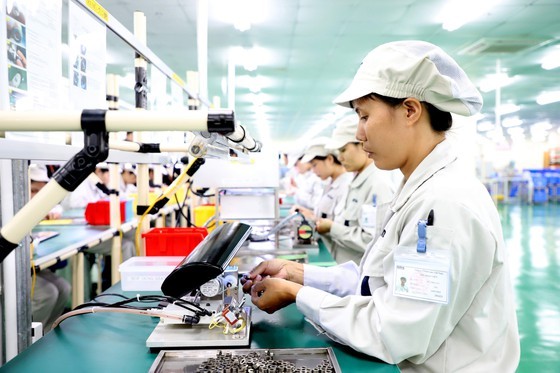 Production at Japanese company, Origin Manufactures Vietnam, in Dong Van Industrial Park in Ha Nam Province. (Photo: SGGP)
Production at Japanese company, Origin Manufactures Vietnam, in Dong Van Industrial Park in Ha Nam Province. (Photo: SGGP)
By the time the National Assembly decided the socio-economic development plan for this year, the shadow of Covid-19 had not appeared yet. Now, although Vietnam has controlled the situation fairly well, in the world, the peak of the pandemic is not over. Economic experts agreed that the socio-economic situation cannot be evaluated in the usual way this year, nor the customary frames and ceilings can be applied mechanically. Though the GDP growth target of 6-6.5 percent for next year seems high, it is in comparison with a low foundation. Therefore, it means that this level is just a step of economic recovery. In that context, many people suggest that an increase of over 1 percent in overspending compared to the plan is acceptable, even necessary, especially when the budget is used to generate demand. At the recent meeting with the Ministry of Planning and Investment (MPI), Mr. Phung Quoc Hien, Deputy Chairman of the National Assembly, also said that regular expenditures would be determinedly cut, and that principle was recurring. However, he was not absolutely opposed to overspending, as long as it is for development investment, because the public investment is the most important leverage. Dr. Nguyen Duc Kien, Head of the Economic Advisory Group of the Prime Minister, said that it is high time the National Assembly (NA) needed to create conditions for the Government and local authorities to operate actively and flexibly, based on the principles that the NA has established. On the one hand, the multi-level approval procedures for investment need reducing. On the other hand, the audit and supervision need to be carried out strictly to ensure the efficiency of investment and avoid losses. The year 2020 is also the time to make plans for the next five-year development path of the country. According to the report on the preliminary assessment of the implementation of the five-year socio-economic development plan in the period from 2016 to 2020 of the MPI, the period from 2016 to 2020 would be the first of the three last five-year plans that the GDP target could be reached if there was no Covid-19 occurrence. Among the total of 18 targets preliminarily evaluated, 14 targets have been met and exceeded, and four targets have failed to achieve, including economic growth rate, GDP per capita, the rate of skilled labor, and the unemployment rate in the urban area. Unfortunately, these four targets determine the health of an economy. Therefore, Mr. Vu Tien Loc, Chairman of the Vietnam Chamber of Commerce and Industry (VCCI), said that there should be breakthrough solutions on all three factors, consisting of institutions, quality of human resources, and infrastructure, to maintain development pace. Regarding the fact that Vietnam has signed new-generation free trade agreements, such as the Comprehensive and Progressive Agreement for Trans-Pacific Partnership (CPTPP) and the Vietnam-EU Free Trade Agreement (EVFTA), VCCI Chairman stressed that the key factor was still institutional reform, opening space for the market to operate most effectively, creating conditions for enterprises to develop creativity and production and business activities. Especially, the forms of business on the digital platform are currently great opportunities, suitable for small and medium-sized enterprises in Vietnam. Sharing Mr. Vu Tien Loc's opinion on market development and operation, Dr. Nguyen Dinh Cung, former Director of the Central Institute for Economic Management, said that the people and enterprises now have had business freedom but lacks business security. In a rapidly changing business environment, along with the uncertainty caused by the impacts of Covid-19, business security is the first factor that investors, domestic or foreign, strong or not strong, all must consider. Therefore, strengthening the judicial system to quickly and satisfactorily settle disputes and protect the interests and assets of investors is the State's most important responsibility in developing the economy and stabilizing society.
